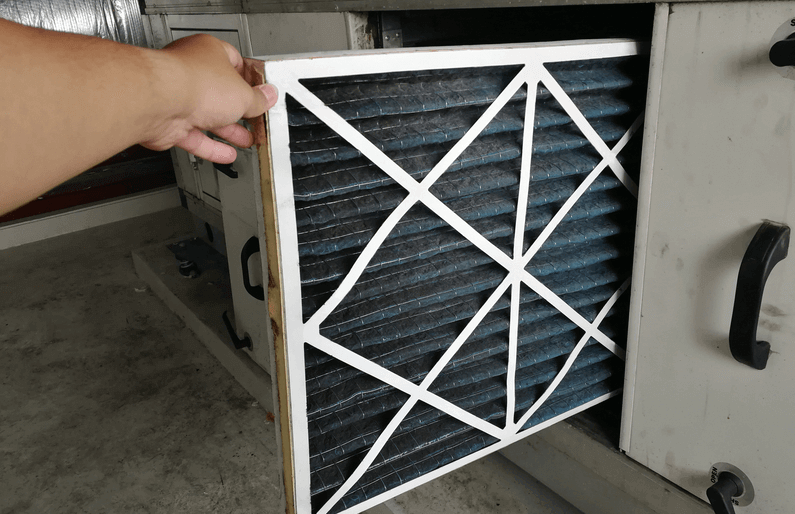Help You?
CLICK TO LEARN MORE ABOUT IRA REBATES AND TAX CREDITS
THE INDOOR AIR QUALITY “FOOD PYRAMID”
The Indoor Air Quality “Food Pyramid”

Indoor air quality is more important than ever when it comes to staying healthy when you’re at home. But, even though there are a lot of ways to improve it, not every strategy is as important as the others.
That’s why we came up with the Indoor Air Quality “Food Pyramid.” It’s a quick overview of how to make the air you breathe cleaner — and how to go about doing it.
My family and I have worked on improving the air quality in our homes for years. Being in the HVAC industry, it was always in my mind somewhere. Now, it seems like a lot more people are catching up.
We’re all spending a lot more time in the house. And, we’re all much more aware of what’s floating in the air around us.
We got serious about it in our house because our son has asthma and would take the most horrible attacks when he was younger. He’s doing great now, and I’m not about to tell you how we found the miracle cure with our HVAC system.
But, I will tell you that those experiences kicked our butts into high gear about our air quality.
Over the years, we installed all sorts of add-ons and enhancements in my homes. Living with the results, my wife and I could see what worked best and what else we needed.
Now, we’re sharing what we’ve learned here with the “Indoor Air Quality Food Pyramid.”
It’s a nod to the old USDA chart, and we’re using this analogy because we believe that some ideas and appliances are more important than others when it comes to indoor air quality (and also because, hey, we remember the 90s!).
And, as we’ve discovered, not everyone considers these steps in this order. We’ve even seen other HVAC professionals jump around a bit. Some of them consider what strategies and products have a higher profit margin over what’s most effective.
But, if you’re getting serious about indoor air quality, here’s what to do — and where to start.
How To Prioritize Indoor Air Quality
These are the four steps you need to take to improve the indoor air quality in your home. We’re listing them in priority: Focus on Number One first, then work your way down.
- Ventilation
- Filtration
- Humidity Control
- Air Purification
We can’t go too in-depth on all of these in this one post. But, we’ll provide links to related articles and explore each topic more in the coming weeks.
Ventilation

Bringing in outside air displaces and dilutes all sorts of contaminants in your home. It’s why spending time outside helps keep people healthy: The air is cleaner.
But, once you close your windows in the summer or winter, all the dirt, pollen, viruses, or whatever else you track inside has nowhere to go. Then, it just builds up and starts irritating or infecting you.
It’s especially a problem with new construction because they don’t build houses that “breathe” anymore. On the one hand, they’re sealed up tight, so you don’t lose heat or cooling. On the other, it’s almost impossible to bring in fresh air without opening the windows.
That’s why ventilation — bringing in fresh air — is the all-important first step toward improving your indoor air quality.
How To Do It
The gold standard is an energy recovery ventilator or ERV. We go into plenty of technical detail here and here. The bottom line is, these appliances bring in fresh air without letting out the heat or air conditioning.
If you’re not ready for that investment, crack a window open even for just a little while every day, even with the heat or air running. Better yet, turn off your system and leave the windows open wide for an hour.
Airing out your home for an hour makes a big difference. But, be warned: you’ll use more energy to warm or cool your home again.
Filtration

How to Do It
Your air filter traps the dirt and dust that passes through a forced-air HVAC system. Ductless heating and cooling setups also use filters, even though they don’t circulate air from one part of the house to another.
In both cases, the filters are standard parts of the system. Your job is to replace the filter once a month on a forced-air system. For ductless, clean the reusable one in each air handler.
The average filters cost less than ten dollars, but you can upgrade to models that catch smaller particles.
Baseboard heating and radiators don’t use filters. They don’t push air around, so they don’t kick up as much dust. But they don’t get rid of any of it, either.
Humidity Control
Viruses can travel further in low humidity. Dry air causes dry, cracking skin and nosebleeds, and those tiny openings in your body allow pathogens to enter it.
Meanwhile, high humidity is a nightmare for people with respiratory problems. Excess moisture makes it harder for people to breathe — the air feels stuffy. And, you get more mold and mildew.
To avoid all this, you want the relative humidity to stay between 40 and 60 percent, no matter what the season.
How To Do It
Step one is buying a humidistat to track your relative humidity levels. Then, use humidifiers in the winter and dehumidifiers in the summer.
You may “get away” with portable models that treat one room at a time. But, the better solution is to get a whole-house humidifier and dehumidifier. Next, consider a sump pump if you get a lot of moisture in the basement.
Air Purification
If you follow these other steps, you’ll notice significant improvements. From there, you can decide how much you need to invest in purifiers to top it all off.
How To Do It
Like humidification, you can choose between portable models and a system that treats the whole house at once. Here, we’re thinking about whole-home solutions.
Many systems use a combination of MERV-rated filters to catch microscopic particles and UV light to eradicate them.
The latest-and-greatest is UV-C light. It gets rid of microorganisms. So, you see new products like UV-C light bulbs out now.
Next are systems ionic charges throughout the house and neutralize microorganisms everywhere. These are especially an option when you don’t have a forced-air system with a filter. But, they’re still new, and the science isn’t always settled.
Where (And How) To Start Improving Your Indoor Air Quality

We went over a lot in this article, and there’s no way you can do it all — at least not at once. We suggest starting with ventilation and working your way down. Decide how much you want to invest, and see what a difference you get starting with some simple solutions.
If you live in the Fox River Valley, you can always call or email Compass Heating and Air for a free consultation. We’ve served homes in Elgin, East Dundee, Barrington, and plenty of other Chicagoland suburbs. And, we’re ready to help you, too.

